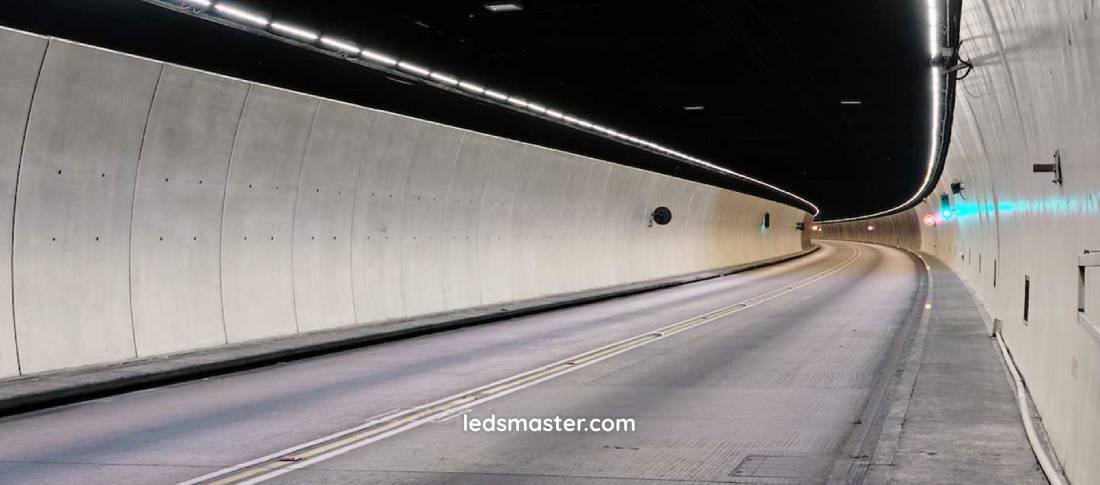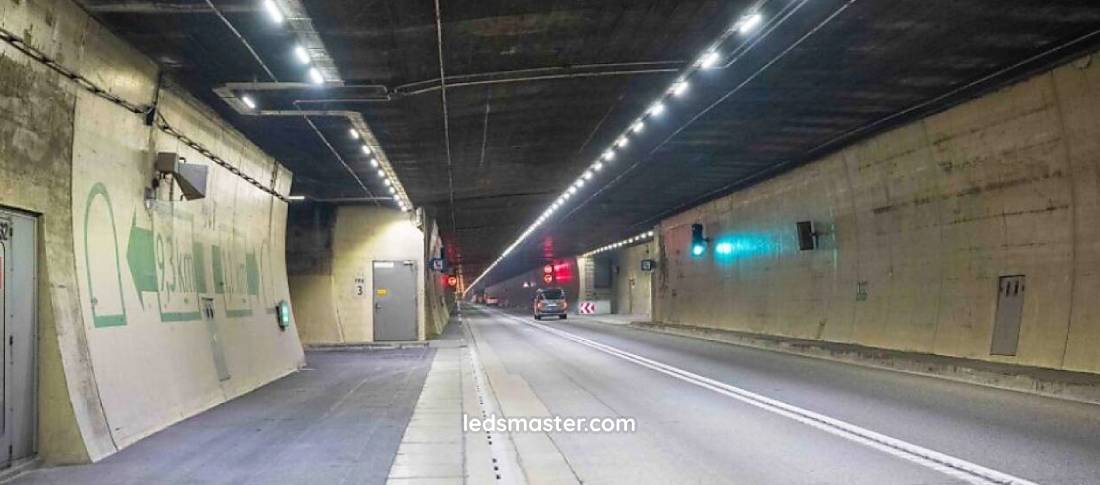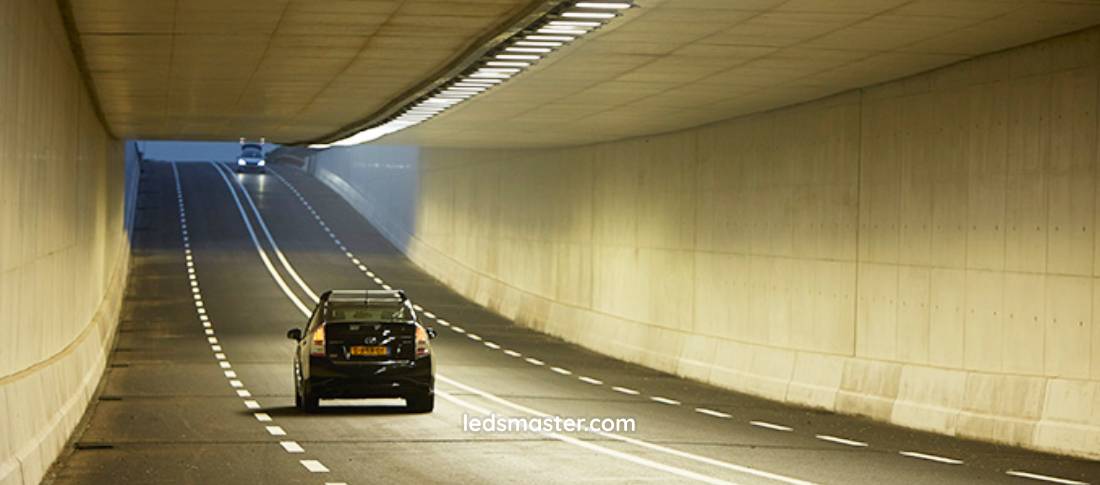Choosing the right color temperature for tunnel lighting impacts safety, visibility, and energy efficiency. Higher temperatures improve contrast, aiding visibility, but may cause glare or discomfort. Warmer temperatures offer comfort, reducing eye strain and fatigue. The balance between these factors, along with considerations like location, traffic type, and design, helps create an optimal lighting solution that ensures a safe, comfortable, and energy-efficient tunnel experience.
Get your complimentary lighting design today
Tunnel lighting is an often overlooked aspect of infrastructure design, yet it has a profound impact on both safety and operational efficiency. The color temperature of tunnel lighting, which refers to the warmth or coolness of light emitted by the lamps, can influence a variety of factors, such as visibility, driver comfort, energy consumption, and maintenance costs. It is important to select the appropriate color temperature that aligns with the needs of the tunnel’s environment and its users.
Table of Contents
Toggle
Selecting the ideal color temperature for tunnel lighting is a complex decision that requires careful consideration of multiple factors, including the tunnel’s geographical location, purpose, design, and the types of vehicles that will be using it. Tunnels, by nature, present unique challenges in terms of visibility and safety, making it essential to choose the right lighting setup to enhance the driving experience while ensuring that energy use and operational costs are kept in check. Color temperature, measured in Kelvin (K), is a key factor in determining how a tunnel’s lighting system will perform.
In general, color temperature refers to the hue or tone of the light emitted by a bulb. Lower Kelvin values (below 3000K) correspond to warmer, yellowish tones, while higher Kelvin values (above 5000K) produce cooler, bluish light. The appropriate color temperature for a particular tunnel largely depends on external factors such as the surrounding light conditions and the specific needs of the tunnel’s users.
The geographical location of a tunnel plays a major role in determining the ideal color temperature. Tunnels located in urban areas, where ambient light levels are typically high, may benefit from cooler light temperatures in the range of 4000K to 5000K. These cooler lights can help differentiate the artificial lighting from the surrounding natural light, making it easier for drivers to adjust as they enter and exit the tunnel. Cool white light tends to provide higher contrast and better visibility, especially in environments that are already exposed to significant amounts of external light.
On the other hand, tunnels located in rural or less illuminated environments often experience a stark contrast between the natural surroundings and the artificial lighting within the tunnel. In such locations, warmer light temperatures, typically ranging from 3000K to 3500K, are often more appropriate. These warmer lights are easier on the eyes, reducing the discomfort that drivers might feel when transitioning from dark, external conditions to the more brightly lit tunnel. The warmer color temperature helps the driver’s eyes adjust more comfortably, minimizing the risk of glare or eye strain during tunnel navigation.

Another important consideration when selecting the ideal color temperature is the primary purpose of the tunnel and the types of vehicles using it. Tunnels on highways or those designed for high-speed traffic may require higher color temperatures in the range of 4000K to 5000K. The reason for this is that cooler lighting enhances the clarity of road markings, lane distinctions, and obstacles at higher speeds. At high speeds, drivers need to quickly identify any potential hazards or changes in the road, and brighter, cooler lighting can assist with that.
In contrast, tunnels designed for slower traffic, such as those found in residential areas or small towns, may benefit from warmer lighting. Tunnels in these areas are typically not used for high-speed traffic, so a lower color temperature in the 3000K to 3500K range may suffice. Warmer lighting is not only more comfortable for drivers who may be entering the tunnel from a darker environment, but it also creates a softer, more calming atmosphere, reducing anxiety and enhancing the overall experience.

The color temperature of lighting in tunnels is an essential factor that directly affects both safety and the visibility of drivers as they navigate through these environments. Tunnels are typically designed to minimize natural light, creating conditions that require artificial lighting to ensure safe passage. In these settings, choosing the right color temperature is critical in ensuring that drivers can clearly see the road, obstacles, lane markings, and signs, all of which are vital for road safety.
Higher color temperatures, particularly those above 4000K, are known to improve contrast, making it easier for drivers to spot road features like lane markings, signs, and obstacles. These benefits are particularly noticeable in tunnels, where natural light is either absent or extremely limited. As the surrounding light levels are diminished, artificial lighting needs to compensate for the darkness. The ability to differentiate road features clearly and effectively can prevent accidents and help drivers maintain proper lane discipline, especially in tunnels that may be long, winding, or poorly illuminated.
Additionally, higher color temperatures can mimic daylight, which can help with visibility, as the human eye is naturally more adapted to such light conditions. For example, lighting at 5000K or higher can offer better contrast in the low-light environment of a tunnel, ensuring that even the smallest road details are discernible. This enhanced visibility is beneficial not only for the drivers but also for maintenance personnel who may need to work inside the tunnel, as they can better perceive the surroundings.
However, while higher color temperatures can improve contrast and visibility, they can also create unwanted effects like glare. Lighting that is excessively cool or too bright can become distracting, causing discomfort to the driver and possibly diminishing their ability to perceive important details in the environment. The human eye is particularly sensitive to high levels of brightness or glare, which can lead to temporary vision impairment or eye strain.
One of the major concerns with lighting above 5000K is that it can be too intense for the eyes, particularly when transitioning from a tunnel’s bright artificial lighting to the darker surroundings outside. This transition can be jarring and disorienting, as the eyes take time to adjust to the drastically different light levels. Excessive brightness can cause fatigue and affect a driver’s ability to quickly adapt to changing light conditions. It’s therefore necessary to find a balance that ensures high visibility without the risk of excessive glare or strain, both of which can impact safety and driver comfort.
In addition to visibility, driver comfort is a vital factor when determining the ideal color temperature for tunnel lighting. Bright, harsh lighting can create strain on the eyes, leading to fatigue and discomfort over time. This is particularly true in tunnels where drivers may be exposed to artificial light for long stretches, such as on highways or in tunnels of considerable length. Over time, exposure to uncomfortable lighting conditions can contribute to driver fatigue, reducing their reaction times and potentially leading to accidents.
On the other hand, lighting that is too dim may cause confusion or anxiety, especially in long or winding tunnels where the environment can already feel constricted and isolated. In such cases, drivers may feel unsure about the road layout, leading to uncertainty about whether they are maintaining their lane or whether there is any obstacle ahead. Low light levels could also lead to difficulties in assessing the road’s curvature or the proximity of other vehicles, all of which could contribute to a sense of unease.
Warmer color temperatures, typically around 3000K, are known to offer a softer, more natural light that can reduce the harshness of brighter, cooler lighting. This type of lighting, which mimics the warm glow of sunrise or sunset, creates a more comfortable environment for drivers. It is particularly useful in tunnels where drivers are expected to spend long periods under artificial lighting, such as those on highways or in urban areas. Warmer lighting provides a more relaxed and soothing atmosphere, which can significantly reduce eye strain, especially for drivers navigating through long or complex tunnels.
Warm lighting is also beneficial because it can help mitigate the stark contrast between the tunnel’s interior lighting and the outside environment. When the lighting inside the tunnel is too cool or bright, the transition to the outside environment becomes much more noticeable and difficult for the eyes. The sharp contrast can be disorienting for drivers, particularly when exiting tunnels onto roads with very different light levels. By using warmer lighting, this transition becomes less jarring, creating a more seamless and comfortable driving experience.
The psychological and physical effects of long-term exposure to harsh lighting in tunnels are often overlooked. Tunnel lighting that is too bright or glaring can contribute to driver fatigue, especially on long journeys. Fatigue is a well-known factor in road accidents, and ensuring that drivers are comfortable and alert during their time in the tunnel is crucial for safety. By choosing a color temperature that provides sufficient illumination without causing discomfort, such as a warm white light around 3000K, tunnel designers can help reduce the likelihood of accidents caused by driver fatigue or distraction.
Moreover, warmer lighting is less likely to create excessive shadows or harsh contrasts that could make the tunnel feel closed in or claustrophobic. In contrast, cooler lights that produce sharp shadows or excessive brightness may make drivers feel uncomfortable and heighten the sense of confinement that often accompanies tunnel travel.
The overall driving experience in a tunnel is shaped not only by the visibility of the road and obstacles but also by how comfortable the environment feels. Too much harsh lighting can make the driver feel overwhelmed, while dim lighting can create feelings of anxiety or disorientation. The appropriate color temperature helps strike a balance between the two extremes, creating an environment that is both functional and comfortable.
Warmer color temperatures contribute to an environment that feels more welcoming and less harsh, offering drivers a smoother experience when passing through tunnels. This is particularly important in tunnels that are long or part of major traffic corridors, as these are often places where drivers spend extended amounts of time.
Choosing the right color temperature for tunnel lighting goes beyond improving visibility and driver comfort; it also plays a significant role in energy efficiency and long-term operational costs. Energy consumption is one of the most important factors to consider when designing or upgrading a tunnel lighting system, as lighting can account for a substantial portion of a tunnel’s operational expenses. The color temperature of the lighting directly influences the amount of energy used by the system, with cooler lights, typically those above 4000K, often consuming more power than warmer lights.
The impact of color temperature on energy efficiency varies based on several factors, such as the type of lighting fixtures used, their wattage, and the specific design of the tunnel. While the overall design and layout of the tunnel play a significant role in determining energy consumption, the color temperature still has a noticeable effect on the total energy demand. Generally, cooler lighting with higher color temperatures, like those above 4000K, requires more energy to produce the desired light output compared to warmer color temperatures, which can be less energy-intensive.
For example, LED lights are widely used in modern tunnel lighting systems due to their energy efficiency and long lifespan. One of the advantages of LEDs is that their color temperature can be adjusted to meet the specific needs of the tunnel without compromising on energy efficiency. However, if the tunnel design opts for fixtures with higher color temperatures—those above 4000K—energy consumption can rise significantly. The increase in power demand can lead to higher operational costs over time, which may not be ideal for tunnels aiming to optimize their energy use.
Tunnels with lighting systems designed for energy efficiency often choose a color temperature in the range of 3500K to 4000K. This range strikes a balance between providing adequate visibility for drivers and minimizing energy consumption. By selecting a slightly warmer color temperature, tunnels can reduce energy usage while still ensuring that drivers have sufficient illumination to navigate safely. Moreover, selecting more energy-efficient lighting technologies, such as LEDs, allows for better control over both the color temperature and the power consumption of the system.
When designing a tunnel lighting system, it’s important to not only consider the initial installation costs but also the long-term operating costs. Lighting systems that use higher color temperatures may require more energy to maintain the desired illumination, resulting in a steady increase in operational expenses. On the other hand, opting for a color temperature that is both effective in providing visibility and optimized for energy efficiency can significantly reduce energy costs, ensuring that the tunnel lighting system remains cost-effective over time.
Additionally, as the demand for sustainable infrastructure grows, energy-efficient lighting systems can contribute to reducing the environmental footprint of tunnel operations. By choosing the right color temperature and using energy-efficient lighting solutions, tunnels can meet both safety and environmental standards while keeping operational costs in check. In the long run, careful selection of color temperature not only impacts the bottom line but also supports the shift toward more sustainable and eco-friendly infrastructure designs.
Another important consideration when determining the best color temperature for tunnel lighting is how the lighting integrates with the tunnel’s design. Tunnels vary greatly in shape, size, and function. Some tunnels are short and straight, while others are long and winding. The color temperature chosen for the lighting will need to complement the layout and structure of the tunnel.
In shorter tunnels, a higher color temperature may be beneficial as it enhances contrast and makes the surroundings appear clearer. However, in longer tunnels with a more complex design, a warmer light may help reduce eye strain and ensure that drivers feel comfortable and secure.
Additionally, tunnels in areas that experience significant seasonal changes in natural light might need lighting systems that can adapt to changing ambient light conditions. For example, in regions where there is a high level of natural sunlight in summer and long periods of darkness in winter, the lighting color temperature may need to be adjusted accordingly to ensure consistency in visibility.
Various organizations around the world have developed guidelines for tunnel lighting, often setting specific recommendations for color temperature. The International Commission on Illumination (CIE) has published standards for tunnel lighting that emphasize the importance of appropriate color rendering and light distribution.
While these standards may vary from country to country, they generally recommend color temperatures in the range of 3000K to 4000K for tunnel lighting to strike a balance between visibility and energy efficiency. Some countries, particularly those with colder climates, may lean toward slightly warmer lighting (around 3000K), while others with warmer climates may prefer cooler lighting (closer to 4000K) for enhanced visibility.
The color temperature of tunnel lighting has a wide-reaching effect on the tunnel’s safety, efficiency, and the comfort of drivers. Selecting the right color temperature is not just about brightness—it involves balancing visibility, energy use, and user experience. By considering factors like the tunnel’s environment, design, and the needs of its users, planners can select a color temperature that optimizes both performance and cost-effectiveness. While the range from 3000K to 5000K is generally recommended, the final choice should be tailored to meet the specific demands of each individual tunnel.